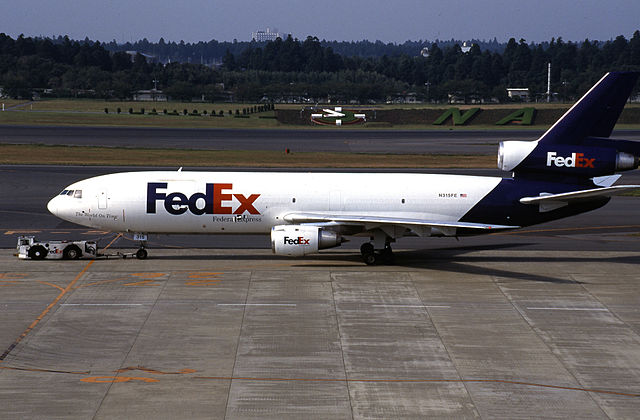Flipping the Bird

On April 7, 1994, a FedEx airplane — a DC-10 like the one pictured above — took off from Memphis, Tennessee with a cargo full of electronics. It did not make it to San Jose, California, its intended destination. It did, however, become one of the first large cargo planes (and perhaps the only one) to fly upside down.
And not only did the pilot avoid reprimand for the maneuver, he was honored for it.
It started with a suicide plot — one designed to avoid being called a suicide. In general, beneficiaries of a life insurance policy will not collect upon a policy if the insured person commits suicide. The reasons for this make sense but is a story for another day (and probably a different publication), so suffice it to say that then-42-year old FedEx flight engineer Auburn Calloway knew about this restriction. He also knew that FedEx’s life insurance policy would pay his family $2.5 million if he were to die in an on-the-job accident. And importantly, he was a FedEx employee who was likely about to be fired, and sadly believed that the best way to care for his family would be to get that $2.5 million, even if it meant taking his own life and the lives of others. His plan was to board a FedEx plane, hijack it, kill everyone on board (ultimately, including himself), all while crashing the plane somewhere.
On that April day, he set his plan into motion. As a FedEx employee who served on flight crews, he was able to board the plane for free and without inviting any undue attention to himself. (It’s very common for airlines and couriers to transport their staff around the country in this manner, a practice called “deadheading,” if for no other reason than to make sure personnel get home or to their next departure destination.) He carried with him a guitar case full of hammers, which he intended to use to bludgeon the three-man crew to death, and a spear gun, in case that didn’t work. Twenty minutes into the flight, Calloway entered the cockpit, hammers in hand, and began his assault. He managed to significantly injure all three members of the flight crew before any could react, and cracked the skulls of both the first officer, James Tucker, and the flight engineer, Andrew Peterson.
But he didn’t manage to kill or incapacitate them. Peterson and the captain, David Sanders, struck back at Calloway, wrestling him to the cockpit floor. All the while, Tucker took the controls to, figuratively, put the pedal to the metal and literally, take the plane for a spin. He pushed the plane to speeds approaching the sound barrier — probably in the realm of 600 miles per hour (or about Mach 0.8), which is the top speed possible by a DC-10.
And then Tucker flipped the plane upside down.
Tucker took the plane into a barrel roll while traveling 400 miles per hour — something a DC-10 is hardly designed to handle. In doing so, though, Tucker made it incredibly difficult for Calloway to cause any further harm to the flight crew, as internal cockpit conditions began fluctuating wildly. As the Cockpit Voice Recorder Database (which has a copy of the understandably PG-13 flight recorder transcript) states:
[T]he three struggling men were tossed about the galley area, alternately weightless and pressed upon by three times their weight in G forces. By now, the aircraft was inverted at 19,700 feet, and the alarmed air traffic controllers in Memphis were desperately calling for Flight 705.
Tucker initiated a series of wild maneuvers. He knew he had to keep the craft’s motion unpredictable, or Calloway would simply wait for the roll to end then resume his attack. Tucker abruptly threw the yoke forward, and sent the plane into a vertical dive. He realized then that the throttle controls, located to his right, were pressed forward to their stops; he could not reach them with his limp right hand. The diving DC-10 accelerated past 500 miles per hour, then past the instruments’ capacity to register. Flight 705 was now traveling faster than any DC-10 had ever gone, and was undergoing velocity stresses that the airframe could not sustain. Somehow, Tucker pulled from the dive, then reached across the yoke with his left hand to cut speed.
The plane landed with all four men alive and the plane, miraculously, intact. Calloway was convicted of air piracy and sentenced to life in prison. The flight crew were honored for their bravery by the Air Line Pilots Association, which awarded them the highest accolade given to civilian pilots. Unfortunately, these honors were among the final steps of these aviators’ careers. Due to the their injuries, none of the them were ever cleared to work a commercial flight again.
The plane itself is still in service.
Bonus Fact: When a plane breaks the sound barrier, it can create a sudden rise in air pressure. This can result in the formation of a halo of water droplets around the airplane, as seen here
From the Archives: Hidden Messages: FedEx’s neat design secret (and that of a few others as well).
Related: A FedEx toy set. (Really, FedEx toys!)
